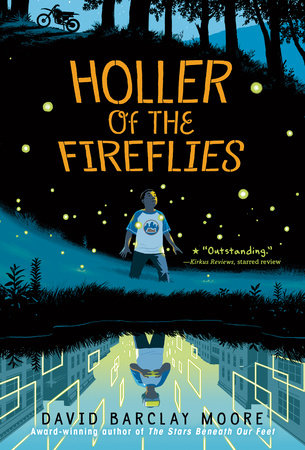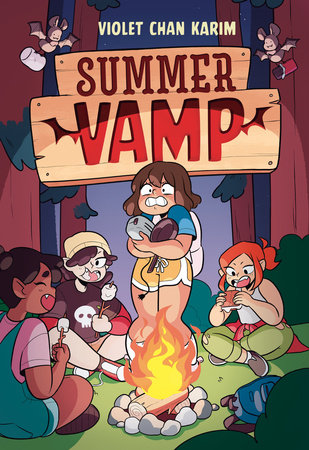
Encounter at Owl Rock by Rucker Moses

Leah vs. Art by Joy McCullough and Veeda Bybee
 The Best Worst Summer of Esme Sun by Wendy Wan-Long Shang
The Best Worst Summer of Esme Sun by Wendy Wan-Long Shang
Esme Sun absolutely does not care about winning shiny trophies or finally receiving some of the praise her mother bestows so lavishly on her three older, brilliant sisters. But, actually… it would be nice to be good at something. So when Esme discovers on the first day of summer, opening day at the community pool, that her growth spurt over the winter has made her a really fast swimmer, she wonders if she just might have found that thing.After Esme has an uncomfortable encounter at the pool with a new girl, Kaya, Esme worries she may have hurt Kaya’s feelings. Then, embarrassed by Esme’s awkwardness, her friend Tegan, the cool girl at school who seems to do everything perfectly, makes Esme promise that from now on, she’ll be chill, not act so babyish and intense about things–especially not swim team.But when their swim competitions begin, and Esme starts winning, she finds that she actually cares a lot. In fact, she wants to break the pool’s freestyle record. That doesn’t mesh so well with her promise to Tegan. And as Esme tries to navigate swimming and her friendships, she searches for a way to apologize and make things right with Kaya.Esme’s mom’s focus on winning confuses her, though, and she begins to wonder: Is winning really as important as she thinks, even if it means being unkind to your friends and teammates? Or is there another way to compete, to be a good sport and a good friend?
Chess Club: The Winning Move by Rebecca Donnelly
AJ Torres and the Treasure of Captain Grayshark by José Pablo Iriarte
When AJ and Jayden discover a gold coin washed up on the shore of Miami after a hurricane, they think it might be the answer to all of their problems.They suspect the dingy old coin may be part of the long lost treasure of Captain Grayshark, whose loot was valued in the millions. That much money could help the Torres’s sinking family business and more importantly, allow Jayden to stay in Miami with his mom, instead of moving miles away from his best friend. The boys set out on a quest, along with resident ghost expert, Andrea Wade, to unearth the pirate’s treasure on a nearby haunted island. But the pursuit of treasure might prove more perilous than they could ever imagine—with treacherous waters and a crew of angry ghost pirates waiting for them on Scream Island . . . A slightly scary, laugh-out loud adventure about searching for gold, but finding much more along the way.
Chef’s Secret (Front Desk #6) by Kelly Yang
Jason Yao has a secret . . . actually, lots of secrets! For one thing, it’s hard being a professional chef, helping to run a motel, and being a regular kid! And now that Mia Tang is officially his girlfriend, Jason’s life has reached a whole new level of exciting–and terrifying! After all, Mia is amazing, and Jason is . . . just Jason. But he’s determined to be the best boyfriend ever, and he knows exactly what he needs to do:
- Plan the perfect first date. Thanks to his dad’s new scheme to bring fancier guests to the motel, Jason is working harder than ever–and earning even bigger tips, which means he can treat Mia to the dinner of her dreams!
- Be less cringe, especially around other guys. And try to make some guy friends his own age! Maybe then he can finally move on from those bullies who tormented him in fourth grade.
- Don’t let Mia know the real him. Mia can never find out the darkest secrets that Jason is keeping–no one can!
Jason knows he’s got his work cut out for him, but hey, if he can date a girl like Mia Tang, anything’s possible, right?
The Incorruptibles by Lauren Magaziner
Fiora Barrowling lives in a world where sorcerers rule over humans. After surviving an encounter with The Radiance—the very worst of the sorcerers—she’s whisked away to the incredible Incorruptibles (“Inc”) Academy, a school for resistance fighters in training. But most of the other students think Fiora hasn’t earned her place there, and when things start to go wrong and it seems the sorcerers have a spy in the academy, all eyes are on Fiora. With all odds stacked against her, can Fiora prove that she belongs?
Bison: Community Builders and Grassland Caretakers by Frances Backhouse
Bison are North America’s largest land animals. Some 170,000 wood bison once roamed northern regions, while at least 30 million plains bison trekked across the rest of the continent. Almost driven to extinction in the 1800s by decades of slaughter and hunting, this ecological and cultural keystone species supports biodiversity and strengthens the ecosystems around it. Bison: Community Builders and Grassland Caretakers celebrates the traditions and teachings of Indigenous Peoples and looks at how bison lovers of all backgrounds came together to save these iconic animals. Learn about the places where bison are regaining a hoof-hold and meet some of the young people who are welcoming bison back home.
Mysteries of the Human Body: Weird and Wonderful Anatomy Explained by Neon Squid and Azmain Chowdhury
- You know your heart is always beating, your intestines digest your food, and even that your brain is still awake when you’re asleep—that’s no mystery. But why do we get “brain freeze” if we eat ice cream too quickly? And why on earth do we get butterflies in our stomach when we’re nervous? And is it true we can squirt milk from our eyes?! This book focuses on the bizarre things all of our bodies do—including things we don’t understand (looking at you, appendix). Dr. Azmain also asks the burning medical questions we’ve all been wondering about:
Why does cilantro taste like soap to some people?
How long can we stay awake for?
Can our hearts actually break after a romantic break-up? (Asking for a friend).Filled with gross, surprising, and downright terrifying facts, it’s bloated with cool science to impress your friends.

Karen Latchana Kenney is a children’s author and editor who loves creating all kinds of STEM books and classroom content. Find her at https://www.karenlatchanakenney.com/.















 Puerto Rican seventh-grader Vale, isn’t going to let her recent car crash keep her from being the top fencer she was before her car accident. This novel in verse gives us a deep understanding of the frustration, identity crushing and disappointment Val experiences as she struggles to regain her top status in fencing. She says, “fencing is what makes me me.” Val’s ready to jump back into competing, but her body isn’t. To make matters worse, the new Cuban American fencer seems to have it all. Val’s crush on the new girl complicates everything. This novel is a realistic look at the emotional journey of recovery.
Puerto Rican seventh-grader Vale, isn’t going to let her recent car crash keep her from being the top fencer she was before her car accident. This novel in verse gives us a deep understanding of the frustration, identity crushing and disappointment Val experiences as she struggles to regain her top status in fencing. She says, “fencing is what makes me me.” Val’s ready to jump back into competing, but her body isn’t. To make matters worse, the new Cuban American fencer seems to have it all. Val’s crush on the new girl complicates everything. This novel is a realistic look at the emotional journey of recovery.







 In Be Prepared, all Vera wants to do is fit in—but that’s not easy for a Russian girl in the suburbs. Her friends live in fancy houses and their parents can afford to send them to the best summer camps. Vera’s single mother can’t afford that sort of luxury, but there’s one summer camp in her price range—Russian summer camp.
In Be Prepared, all Vera wants to do is fit in—but that’s not easy for a Russian girl in the suburbs. Her friends live in fancy houses and their parents can afford to send them to the best summer camps. Vera’s single mother can’t afford that sort of luxury, but there’s one summer camp in her price range—Russian summer camp.







